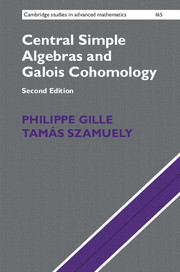Book contents
- Frontmatter
- Contents
- Preface
- 1 Quaternion algebras
- 2 Central simple algebras and Galois descent
- 3 Techniques from group cohomology
- 4 The cohomological Brauer group
- 5 Severi–Brauer varieties
- 6 Residue maps
- 7 Milnor K-theory
- 8 The Merkurjev–Suslin theorem
- 9 Symbols in positive characteristic
- Appendix: a breviary of algebraic geometry
- Bibliography
- Index
6 - Residue maps
Published online by Cambridge University Press: 07 August 2017
- Frontmatter
- Contents
- Preface
- 1 Quaternion algebras
- 2 Central simple algebras and Galois descent
- 3 Techniques from group cohomology
- 4 The cohomological Brauer group
- 5 Severi–Brauer varieties
- 6 Residue maps
- 7 Milnor K-theory
- 8 The Merkurjev–Suslin theorem
- 9 Symbols in positive characteristic
- Appendix: a breviary of algebraic geometry
- Bibliography
- Index
Summary
Residue maps constitute a fundamental technical tool for the study of the cohomological symbol. Their definition is not particularly enlightening at a first glance, but the reader will see that they emerge naturally during the computation of Brauer groups of function fields or complete discretely valued fields. When one determines these, a natural idea is to pass to a field extension having trivial Brauer group. There are three famous classes of such fields: finite fields, function fields of curves over an algebraically closed field and complete discretely valued fields with algebraically closed residue field. Once we know that the Brauer groups of these fields vanish, we are able to compute the Brauer groups of function fields over an arbitrary perfect field. The central result here is Faddeev's exact sequence for the Brauer group of a rational function field. We give two important applications of this theory: one to the class field theory of curves over finite fields, the other to constructing counterexamples to the rationality of the field of invariants of a finite group acting on some linear space. Following this ample motivation, we finally attack residue maps with finite coefficients, thereby preparing the ground for the next two chapters.
Residue maps for the Brauer group first appeared in the work of the German school on class field theory; the names of Artin, Hasse and F. K. Schmidt are the most important to be mentioned here. It was apparently Witt who first noticed the significance of residue maps over arbitrary discretely valued fields. Residue maps with finite coefficients came into the foreground in the 1960s in the context of étale cohomology; another source for their emergence in Galois cohomology is work by Arason [1] on quadratic forms.
Cohomological dimension
Before embarking on the study of fields with vanishing Brauer group it is convenient to discuss the relevant cohomological background: this is the theory of cohomological dimension for profinite groups, introduced by Tate.
Recall that for an abelian group B and a prime number p, the notation B﹛p﹜ stands for the p-primary torsion subgroup of B, i.e. the subgroup of elements of p-power order.
- Type
- Chapter
- Information
- Central Simple Algebras and Galois Cohomology , pp. 163 - 214Publisher: Cambridge University PressPrint publication year: 2017



